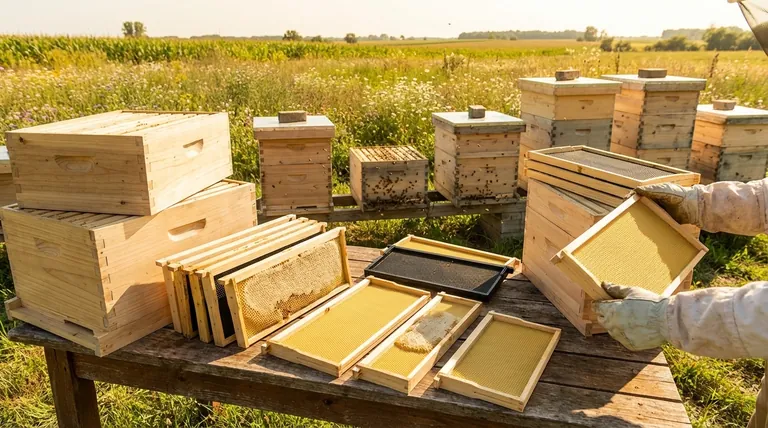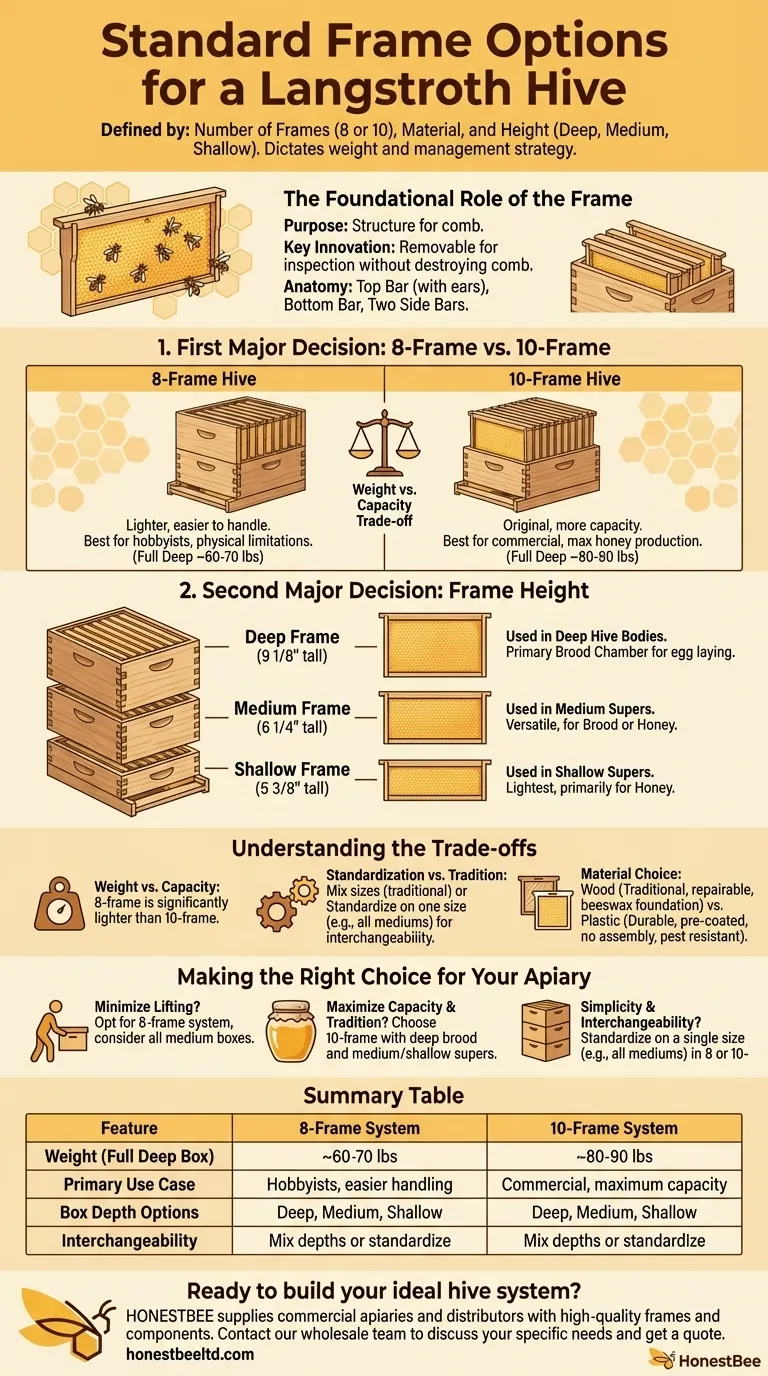The standard frame options for a Langstroth hive are defined by three primary factors: the number of frames per box (8 or 10), their material (most commonly wood or plastic), and their height, which must correspond to one of the three standard box depths—Deep, Medium, or Shallow. These choices dictate the weight of your equipment and your overall hive management strategy.
Choosing your hive frames is less about the individual frame and more about committing to a system. Your decision between 8-frame and 10-frame equipment, and between different box depths, will determine the weight you lift and how you manage your bees for years to come.

The Foundational Role of the Frame
Before comparing options, it's critical to understand why frames are the centerpiece of the modern Langstroth hive. Their purpose is to provide a structure for bees to build their comb on.
A System for Inspection
The key innovation of this design is that the frames are removable. This allows a beekeeper to pull out, inspect, and manipulate individual sections of the hive without destroying the colony's delicate comb structure.
Basic Frame Anatomy
Each frame is a simple rectangle, typically made of four pieces of wood: a top bar, a bottom bar, and two side bars. The top bar has extended "ears" that rest on a notched ledge inside the hive box called a rabbet, allowing the frame to hang securely while maintaining the correct spacing.
The First Major Decision: 8-Frame vs. 10-Frame
Your first choice establishes the width of your entire hive. All components—from the bottom board to the top cover—must match this decision.
The 10-Frame Standard
This is the original, traditional configuration for Langstroth hives. It offers more space per box for brood rearing and honey storage, making it the most common choice in commercial operations.
The 8-Frame Alternative
This narrower version was developed specifically to be lighter and easier to handle. Since it holds two fewer frames, each box is significantly lighter when full of bees, brood, and honey, making it a popular choice for hobbyists or those with physical limitations.
The Second Major Decision: Frame Height
Frames come in different heights to match the three standard Langstroth box depths. You can mix and match box sizes on a single hive, but the frame must always match the box it goes into.
Deep Frames (9 1/8" tall)
These are the largest frames and are used in the deep hive bodies, which typically serve as the brood chamber. This is where the queen lays her eggs and the colony raises its young.
Medium Frames (6 1/4" tall)
Used in "medium supers," these are a versatile intermediate size. Some beekeepers use them for both brood and honey, while others use them exclusively for honey supers placed above the brood chamber.
Shallow Frames (5 3/8" tall)
These are the smallest frames and are used in "shallow supers." They are almost exclusively used for honey production, as their lighter weight makes them the easiest to lift when full.
Understanding the Trade-offs
There is no single "best" option. Your choice depends entirely on your goals and physical abilities.
Weight vs. Capacity
The core trade-off between an 8-frame and 10-frame system is weight. A full 10-frame deep box can weigh 80-90 pounds, while a full 8-frame deep is closer to 60-70 pounds. While the 10-frame hive has more space, the 8-frame is far easier to manage physically.
Standardization vs. Tradition
The traditional setup uses large deep boxes for brood and smaller medium or shallow boxes for honey. However, many beekeepers now choose to standardize on a single box size (usually all mediums) for the entire hive. This means every frame and box is interchangeable, dramatically simplifying equipment management.
Material Choice: Wood vs. Plastic
Wooden frames are traditional, biodegradable, and allow for using pure beeswax foundation. They require assembly but are easily repaired. Plastic frames, often sold as a single pre-coated piece, are extremely durable, resist pests like wax moths, and require no assembly, saving significant time.
Making the Right Choice for Your Apiary
Analyze your goals to select the system that best suits your needs.
- If your primary focus is minimizing heavy lifting: Opt for an 8-frame system, and strongly consider using all medium-depth boxes for both brood and honey.
- If your primary focus is maximizing honey capacity and following tradition: A 10-frame system with deep brood boxes and medium or shallow honey supers is the standard path.
- If your primary focus is simplicity and interchangeability: Standardizing on a single box size (like all mediums) in either an 8 or 10-frame configuration will simplify your equipment needs.
Ultimately, the best frame system is the one you can manage comfortably and consistently.
Summary Table:
| Feature | 8-Frame System | 10-Frame System |
|---|---|---|
| Weight (Full Deep Box) | ~60-70 lbs | ~80-90 lbs |
| Primary Use Case | Hobbyists, easier handling | Commercial, maximum capacity |
| Box Depth Options | Deep, Medium, Shallow | Deep, Medium, Shallow |
| Interchangeability | Mix depths or standardize (e.g., all mediums) | Mix depths or standardize (e.g., all mediums) |
Ready to build your ideal hive system?
At HONESTBEE, we supply commercial apiaries and beekeeping equipment distributors with the high-quality, durable frames and hive components they need to succeed. Whether you're standardizing on 8-frame mediums for easier management or building out a high-capacity 10-frame operation, we provide the reliable equipment for a productive season.
Contact our wholesale team today to discuss your apiary's specific needs and get a quote.
Visual Guide

Related Products
- Langstroth Bee Hives Bee Keeping Box for Beginners Beekeeping
- Long Langstroth Style Horizontal Top Bar Hive for Wholesale
- Professional 3-Bar Frame Grip with Integrated Hive Tool
- HONESTBEE Professional Multi-Functional Hive Tool with Ergonomic Wood Handle
- HONESTBEE Professional Long Handled Hive Tool with Precision Cutting Blade
People Also Ask
- How does the orientation of the hive sides benefit comb construction? Ensure Straight, Movable Combs for Easier Hive Management
- What are the key features of the Langstroth beehive? A Guide to the Standard for Modern Beekeeping
- Should a beginner try a different type of hive? Start with a Langstroth for a solid foundation.
- What basic equipment is needed to start beekeeping? Your Essential Guide to a Confident Start
- Why are Langstroth hives recommended for beginners? Unmatched Support & Standardization



















